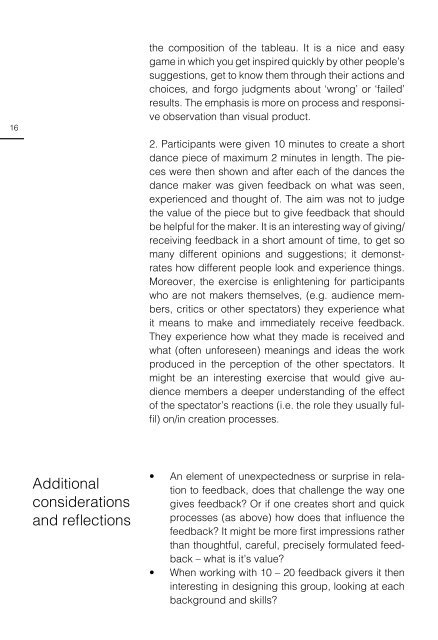Laboratory on Feedback in Artistic Processes 1
Feed-back is everywhere, and as a means to reflect, gather and share resources and methods on this expanding field the “Laboratory on Feedback in Artistic Processes” was initiated within the frame of “Teachback” – one of the modules of the project “Life Long Burning” 1 in collaboration with HZT Berlin and Uferstudios Berlin. The lab, held in January 2014, invited a group of people who shared an interest in the topic of feedback. Over the three days the group practiced, articulated and discussed different approaches, aims and experiences of existing methods of feedback. The idea was that a number of feedback-methods should be applied and tried out within the lab, as opposed to merely remaining on a theoretical discursive level. The document functions as a summarized report on the feedback lab; it collates the remarks from the invited observers, who were Inge Koks and Frederik Le Roy. Through a chronological order the document mainly gives a brief summary on each participant’s contribution with additional considerations and reflections on the proposed method or presentation. This short paper is written firstly as a documentation for those who partook in the lab and secondly, as a reference for those who will participate in a follow up format about feedback. IMPRINT Text by Sheena McGrandles, Nik Haffner, Inge Koks, Frederik Le Roy Photos, Layout and Editing Sheena McGrandles Editor: HZT Berlin, 2014
Feed-back is everywhere, and as a means to reflect, gather and share resources and methods on this expanding field the “Laboratory on Feedback in Artistic Processes” was initiated within the frame of “Teachback” – one of the modules of the project “Life Long Burning” 1 in collaboration with HZT Berlin and Uferstudios Berlin.
The lab, held in January 2014, invited a group of people who shared an interest in the topic of feedback. Over the three days the group practiced, articulated and discussed different approaches, aims and experiences of existing methods of feedback. The idea was that a number of feedback-methods should be applied and tried out within the lab, as opposed to merely remaining on a theoretical discursive level.
The document functions as a summarized report on the feedback lab; it collates the remarks from the invited observers, who were Inge Koks and Frederik Le Roy. Through a chronological order the document mainly gives a brief summary on each participant’s contribution with additional considerations and reflections on the proposed method or presentation. This short paper is written firstly as a documentation for those who partook in the lab and secondly, as a reference for those who will participate in a follow up format about feedback.
IMPRINT
Text by Sheena McGrandles, Nik Haffner, Inge Koks, Frederik Le Roy
Photos, Layout and Editing Sheena McGrandles
Editor: HZT Berlin, 2014
Create successful ePaper yourself
Turn your PDF publications into a flip-book with our unique Google optimized e-Paper software.
the compositi<strong>on</strong> of the tableau. It is a nice and easy<br />
game <strong>in</strong> which you get <strong>in</strong>spired quickly by other people’s<br />
suggesti<strong>on</strong>s, get to know them through their acti<strong>on</strong>s and<br />
choices, and forgo judgments about ‘wr<strong>on</strong>g’ or ‘failed’<br />
results. The emphasis is more <strong>on</strong> process and resp<strong>on</strong>sive<br />
observati<strong>on</strong> than visual product.<br />
• How does the process of feedback change over<br />
time - for example when <strong>on</strong>e gets to know <strong>on</strong>e another<br />
and the feedback then seems to be less careful.<br />
16 17<br />
2. Participants were given 10 m<strong>in</strong>utes to create a short<br />
dance piece of maximum 2 m<strong>in</strong>utes <strong>in</strong> length. The pieces<br />
were then shown and after each of the dances the<br />
dance maker was given feedback <strong>on</strong> what was seen,<br />
experienced and thought of. The aim was not to judge<br />
the value of the piece but to give feedback that should<br />
be helpful for the maker. It is an <strong>in</strong>terest<strong>in</strong>g way of giv<strong>in</strong>g/<br />
receiv<strong>in</strong>g feedback <strong>in</strong> a short amount of time, to get so<br />
many different op<strong>in</strong>i<strong>on</strong>s and suggesti<strong>on</strong>s; it dem<strong>on</strong>strates<br />
how different people look and experience th<strong>in</strong>gs.<br />
Moreover, the exercise is enlighten<strong>in</strong>g for participants<br />
who are not makers themselves, (e.g. audience members,<br />
critics or other spectators) they experience what<br />
it means to make and immediately receive feedback.<br />
They experience how what they made is received and<br />
what (often unforeseen) mean<strong>in</strong>gs and ideas the work<br />
produced <strong>in</strong> the percepti<strong>on</strong> of the other spectators. It<br />
might be an <strong>in</strong>terest<strong>in</strong>g exercise that would give audience<br />
members a deeper understand<strong>in</strong>g of the effect<br />
of the spectator’s reacti<strong>on</strong>s (i.e. the role they usually fulfil)<br />
<strong>on</strong>/<strong>in</strong> creati<strong>on</strong> processes.<br />
References<br />
Susan Rethorst, “A Choreographic M<strong>in</strong>d: Autobodygraphical<br />
Writ<strong>in</strong>gs” (Publisher: Teatterikorkeakoulu (2012),<br />
ISBN number 978-952-9765-70-6)<br />
Additi<strong>on</strong>al<br />
c<strong>on</strong>siderati<strong>on</strong>s<br />
and reflecti<strong>on</strong>s<br />
• An element of unexpectedness or surprise <strong>in</strong> relati<strong>on</strong><br />
to feedback, does that challenge the way <strong>on</strong>e<br />
gives feedback? Or if <strong>on</strong>e creates short and quick<br />
processes (as above) how does that <strong>in</strong>fluence the<br />
feedback? It might be more first impressi<strong>on</strong>s rather<br />
than thoughtful, careful, precisely formulated feedback<br />
– what is it’s value?<br />
• When work<strong>in</strong>g with 10 – 20 feedback givers it then<br />
<strong>in</strong>terest<strong>in</strong>g <strong>in</strong> design<strong>in</strong>g this group, look<strong>in</strong>g at each<br />
background and skills?


















